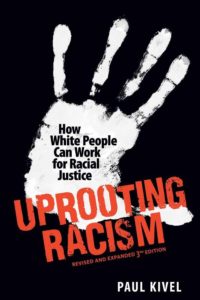How White People Can Work for Racial Justice

The following is excerpted from Paul Kivel’s Uprooting Racism: How White People Can Work for Racial Justice, 4th Edition, New Society Publishers, September 2017.
PART III: BEING ALLIES
Showing Up as a Strong White Ally
People of color I have talked with over the years have been remarkably consistent in describing the kinds of support they need from white allies. The following list is compiled from their statements. The focus here is on personal qualities and interpersonal relationships. More active interventions are discussed in the next part of the book.

An Ally Is Not a Hero or Savior
If we are working from an understanding of mutual interest and responding to what people of color say they need from white people, it should be clear the struggle for racial justice is not about white people saving, rescuing, or “helping” people of color.
We’ve been taught white men built, produced, discovered, or created everything of importance in the world. We’ve been taught people of color have been lazy and unambitious. We’ve seen or read about all the great white male saviors from Jesus to Medieval knights; from Columbus to the Founding Fathers; from Western gunslingers to contemporary comic book, movie, and video game superheroes. It is always white men and Western civilization who protect the family/town/nation/women/children/Western civilization from dangerous others. This constantly reiterated cosmology of saviors bringing salvation can make it hard for individual white people not to assume we are the current leading edge of the salvation effort bringing democracy, “free” markets, humanitarian aid, equality, justice, safety, etc. to “those in need.” In fact, a lot of the violence initiated by white people and by the US globally is in the name of self-righteous efforts to help people.
Other people don’t need to be rescued. Allies aren’t heroes. They are members of the community who understand injustice when they see it and do what they can to work with others to redress it.
Basic Tactics
Although every situation is different, taking the previous statements into account, I have compiled some general guidelines.
1. Assume racism is everywhere, every day. Racism affects whatever is going on. We assume this because it’s true and because one of the privileges of being white is not having to see or deal with racism all the time. We have to learn to see the effect racism has. Notice who speaks, what is said, how things are done and described. Notice who is not present. Notice code words for race and the implications of the policies, patterns, and comments being expressed. You already notice the skin color of everyone you meet and interact with—now notice what difference it makes.
2. Notice who is the center of attention and who is the center of power. Racism works by directing violence and blame toward people of color and consolidating power and privilege for white people.
3. Notice how racism is denied, minimized, and justified.
4. Assume our whiteness is also a factor. We should look for ways we are acting from assumptions of white power or privilege. This will allow us to see our tendency to defend ourselves or to assume we should be in control.
5 Understand and learn from the history of whiteness and racism. Notice how racism has changed over time and how it has subverted or resisted challenges. Study the tactics that have worked effectively against it.
6. Understand the connections between racism, economic issues, sexism, and other forms of injustice.
7. Take a stand against injustice. Take risks. It is scary, difficult and may bring up feelings of inadequacy, lack of self-confidence, indecision, or fear of making mistakes—but ultimately it is the only healthy and moral human thing to do. Intervene in situations where racism is being enacted.
8. Be strategic. Decide what is important to challenge and what’s not. Think about strategy in particular situations. Confront the source of power.
9. Don’t confuse a particular struggle with larger issues. Behind particular incidents and interactions are larger patterns. Racism is flexible and adaptable. There will be gains and losses in the struggle for justice and equality.
10. Don’t call names or be personally abusive. We usually end up abusing people who have less power than we do because it is less dangerous. Attacking people doesn’t address the systemic nature of racism and inequality.
11. Support the leadership of people of color and POC-led organizations.
12. Learn something about the history of white people who have worked for racial justice. This is a long history. Their stories can inspire and sustain you.
13. Don’t do it alone. You will not end racism by yourself. We can do it if we work together. Build support, establish networks, and work with already established groups.
14. Talk with your children and other young people about racism.
